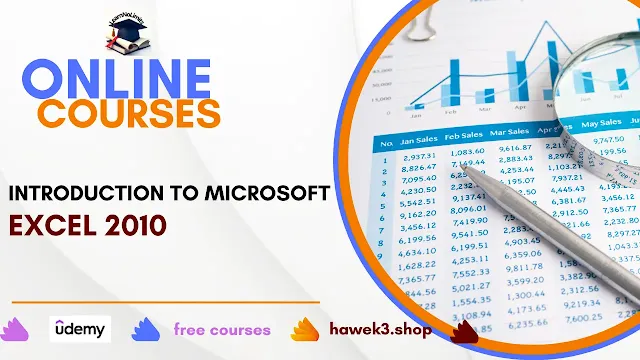Microsoft Excel 2010 for Beginners: Master Spreadsheets Without the Overwhelm
If you’ve ever opened Excel and felt like you’re staring at a plane's cockpit—buttons everywhere, menus within menus, and no idea where to start—this guide is your co-pilot.
Microsoft Excel 2010 isn’t just software. It’s a gateway to organizing data, automating calculations, and presenting information with clarity. Whether you’re managing household budgets, tracking project deadlines, or stepping into an office role, this free course will turn Excel from a headache into your most trusted tool.
Let’s begin.
What You Will Learn
This isn’t a superficial overview. By the end of this course, you’ll confidently:
Enter and format text, numbers, and dates without accidentally breaking your spreadsheet.
Write basic formulas using the correct order of operations (no math degree required).
Save files strategically by choosing the right format for sharing or editing.
Freeze rows and columns to keep headers visible while scrolling through massive datasets.
You’ll also master navigation tricks, mouse shortcuts, and workbook organization—skills that save hours over a career.
Prerequisites: What You Need
Microsoft Excel 2010 installed: Versions matter. The course uses Excel 2010’s interface, but most concepts apply to newer editions.
A willingness to click: No prior Excel knowledge needed. Curiosity is your only prerequisite.
Why This Course Works
Most Excel trainings overwhelm beginners with jargon. This one is different. Designed by instructors who’ve taught thousands of new users, it focuses on:
Practical first steps: Learn by doing, from creating your first workbook to printing polished sheets.
Avoiding common pitfalls: Fix mistakes like misplaced formulas or lost files before they happen.
Real-world relevance: Practice with scenarios like budgeting, inventory lists, or project tracking.
You’ll finish with skills you’ll use daily—not theoretical concepts you’ll forget.
Who This Course Is For
This course is for anyone who’s ever:
Hesitated to apply for a job requiring “basic Excel skills.”
Struggled to organize data in a way that makes sense.
Watched colleagues breeze through spreadsheets and thought, “I wish I could do that.”
Specifically, it’s perfect for:
Career changers entering administrative or data-driven roles.
Small business owners tracking expenses or client information.
Students managing group projects or thesis data.
Retirees or parents organizing schedules, hobbies, or household tasks.
If you’ve labeled yourself “tech-challenged,” this course will rewrite that story.
Course Content: Your Learning Blueprint
1. Introduction to Excel (21 Minutes)
First impressions: Demystify the Excel interface—ribbons, cells, formula bars.
Mouse mastery: Navigate like a pro with clicks, drags, and right-click shortcuts.
Customize your workspace: Adjust settings to fit your workflow (e.g., default font, autosave).
2. Creating a New Workbook (24 Minutes)
Data entry basics: Type text, numbers, and dates without formatting disasters.
Formulas 101: Add, subtract, and multiply using +, -, *, and /.
Order of operations: Avoid calculation errors by mastering PEMDAS (Parentheses, Exponents, Multiplication/Division, Addition/Subtraction).
Range selection: Highlight groups of cells for faster editing.
3. Saving Workbooks (9 Minutes)
Save vs. Save As: Know when to overwrite files and when to create copies.
File formats decoded: Choose between .xlsx (standard), .xls (older versions), and PDFs for sharing.
4. Navigating Workbooks (18 Minutes)
Open and organize files: Handle large datasets without losing your place.
Freeze Panes: Lock headers in place while scrolling through endless rows.
Split Screen: Compare different sections of a spreadsheet side by side.
Why These Skills Matter
Imagine this: Your child’s school asks for a volunteer to manage the fundraiser budget. Instead of dodging the request, you:
Create a clean spreadsheet with income/expense columns.
Use formulas to auto-calculate totals.
Freeze the header row so donors stay visible as you scroll.
Total time: 12 minutes.
That’s the power of foundational Excel skills.
Common Beginner Mistakes (And How to Avoid Them)
Forgetting to save: Enable autosave or set a timer to save every 15 minutes.
Misaligned data: Use “Freeze Panes” to keep headers locked.
Formula errors: Always start formulas with = and double-check parentheses.
Your First Assignment
Open Excel 2010.
Click “Blank Workbook.”
Type “My First Spreadsheet” in cell A1.
Press Ctrl + S and save the file as “Practice.xlsx.”
Congratulations—you’ve officially begun.
Real-World Applications
Home use: Track grocery spending, holiday gift lists, or workout progress.
Office tasks: Manage client contact lists, meeting schedules, or inventory.
Academic projects: Organize research data, survey results, or group timelines.
Excel isn’t just for accountants. It’s for anyone who deals with information.
Why “Freeze Panes” Is a Game-Changer
Scrolling through rows of data without context is like reading a book with no chapter titles. Freezing headers:
Prevents confusion: Always see which column holds “Sales” vs. “Expenses.”
Saves time: No more scrolling up to remember what each column means.
It’s a simple trick with outsized impact.
Final Thought: Excel Is a Lifelong Skill
Unlike trendy apps that come and go, Excel has been a workplace staple for decades. Learning it:
Boosts employability: 82% of middle-skill jobs require spreadsheet skills.
Saves time: Automate repetitive tasks and focus on high-value work.
Reduces stress: Transform data chaos into order.
Ready to Begin? Dive Into This Free Course!
No payments. No trials. Just practical skills:
Start small: Master one lesson daily.
Practice immediately: Recreate a real-life task (e.g., a grocery list).
Celebrate progress: Every click is a step toward confidence.
Your Moment of Clarity
The next time someone says, “Put it in a spreadsheet,” you won’t panic. You’ll open Excel and think, “I’ve got this.”
Because you do.
Learn: Free Course: Pivot Tables Playground for Business Users

